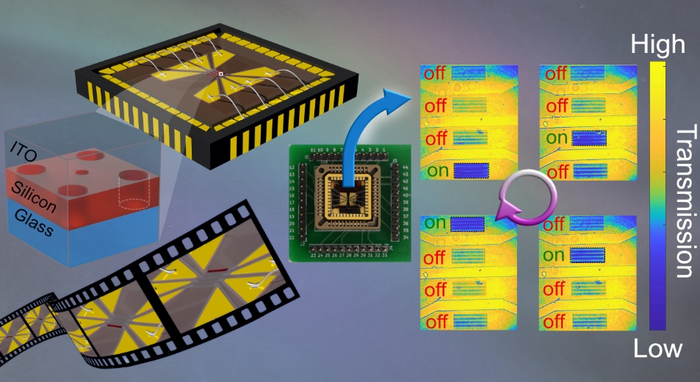Continuously lit by a backlight, liquid crystal cells switch transmitted light on and off. Polarizing filters in the front and also behind the pixels form a cross-polarized structure.
 Left panel demonstrates the components of the fabricated sample and right panels show the experimental switching of fabricated metasurface pixels connected to a printed circuit board. Image Credit: by Khosro Zangeneh Kamali, Lei Xu, Nikita Gagrani, Hark Hoe Tan, Chennupati Jagadish, Andrey Miroshnichenko, Dragomir Neshev, and Mohsen Rahmani
Left panel demonstrates the components of the fabricated sample and right panels show the experimental switching of fabricated metasurface pixels connected to a printed circuit board. Image Credit: by Khosro Zangeneh Kamali, Lei Xu, Nikita Gagrani, Hark Hoe Tan, Chennupati Jagadish, Andrey Miroshnichenko, Dragomir Neshev, and Mohsen Rahmani
In a new study reported in the journal Light Science & Application, scientists have illustrated a proof of concept technology that set the stage for “next-generation” displays over present LEDs and LCDs available. This allows screens and electronic devices to turn thinner, provide higher resolution, and be highly energy efficient.
A research group, at Nottingham Trent University in the UK, the Australian National University, and the University of New South Wales Canberra in Australia, has designed electrically tuneable arrays of nanoparticles known as “metasurfaces.” This could provide considerable advantages over existing liquid crystal displays.
The newly fabricated metasurface cells—which have tunability and remarkable light scattering properties—would substitute the liquid crystal layer and would not need the polarizers. This is accountable for energy use in displays and a huge amount of wasted light intensity. The metasurfaces are 100 times thinner compared to the liquid crystal cells, provide a tenfold greater resolution, and use 50% less energy.
As part of the study, the research group illustrated that pixels could be electrically programmed and the light could be switched nearly 20 times faster than the human aversion response time by altering the material’s temperature.
The scientists believe their technology is compatible with advanced electronic displays and bridges a technological gap for tuneable metasurfaces that has the potential to switch light in an effective manner at high frequencies.
We have paved the way to break a technology barrier by replacing the liquid crystal layer in current displays with a metasurface, enabling us to make affordable flat screens liquid crystal-free.
Mohsen Rahmani, Study Lead Researcher and Professor, Engineering, School of Science and Technology, Nottingham Trent University
Rahmani added, “The most important metrics of flat panel displays are pixel size and resolution, weight, and power consumption. We have addressed each of these with our meta-display concept.”
“Most importantly, our new technology can lead to a huge reduction of energy consumption – this is excellent news given the number of monitors and TV sets being used in households and businesses every single day. We believe it is time for LCD and LED displays to be phased out in the same way as former cathode ray tube (CRT) TVs over the past ten to 20 years,” continued Rahmani.
Dragomir Neshev, Director of the ARC Centre for Excellence in Transformative Meta-Optical Systems (TMOS) and Australian National University Professor in Physics, stated, “The capability of conventional displays has reached its peak and is unlikely to significantly improve in the future due to multiple limitations.”
“Today there is a quest for fully solid-state flat display technology with a high-resolution and fast refresh rate. We have designed and developed metasurface pixels that can be ideal for the next-generation display. Unlike liquid crystals, our pixels do not require polarised lights for functioning, which will halve screens’ energy consumption.”
Metasurfaces are proven to exhibit extraordinary optical behavior. However, inventing an effective way to control them is still a subject of heavy research. We have proposed electrically programmable silicon metasurfaces, which is a versatile platform for programmable metasurfaces.
Khosro Zangeneh Kamali, Study First Author and PhD Scholar, Australian National University
Dr. Lei Xu, a team member from Nottingham Trent University, said “There is significant room for further improvements by employing artificial intelligence and machine learning techniques to design and realize even smaller, thinner, and more efficient metasurface displays.”
Our pixels are made of silicon, which offers a long-life span in contrast with organic materials required for other existing alternatives. Moreover, silicon is widely available, CMOS compatible with mature technology, and cheap to produce.
Andrey Miroshnichenko, Professor and Team Member, University of New South Wales Canberra
Miroshnichenko came to the conclusion that it was believed the development could help produce a frontier technology in new flat displays with a global market value of nearly $117 billion in 2020.
Journal Reference:
Kamali, K. Z., et al. (2023) Electrically programmable solid-state metasurfaces via flash localized heating. Light Science & Applications. doi.org/10.1038/s41377-023-01078-6.